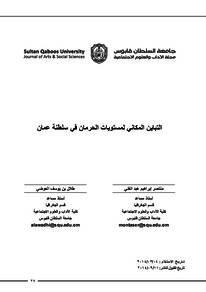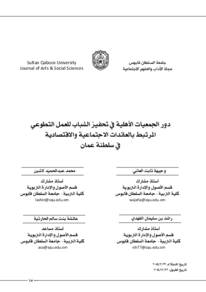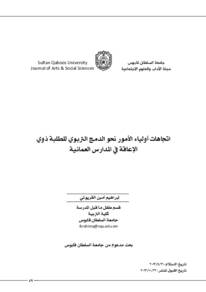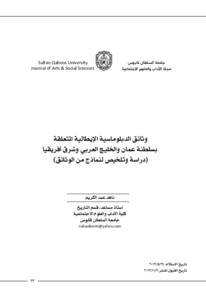Document
التباين المكاني لمستويات الحرمان في سلطنة عمان.
Contributors
العوضي, طلال بن يوسف., Author
Publisher
جامعة السلطان قابوس. كلية الآداب والعلوم الاجتماعية
Gregorian
2016
Language
Arabic
English abstract
In recent decades indicators and statistical methods have been developed to measure the levels of multiple deprivations in economic and social aspects. The aim is to identify the geographical areas which suffer from deprivation in some of these aspects, in order to know their developmental needs, and then to focus the support and development processes there. The most important indices that have evolved in this context are; the Jarman index, also known as the «Underprivileged Area Score», the «Townsend deprivation index», and the «Carstairs deprivation Index». Since the 1980s, the Carstairs deprivation index has become well-known, especially after it was used - with some modification - in the measurement of indices of deprivation in the countries of the United Kingdom by the «Social Disadvantages Research Center-SDRS» at the University of Oxford. This study aims to measure the levels of deprivation in the Sultanate of Oman using the Carstairs index, to discover the more and less deprived wilayates in the seven domains reflecting the social and economic status of the population, namely: education, skills, employment, health, housing, living environment, facilities and household appliances. These domains include fourteen variables, with data derived from the population census of Oman in 2010. The Carstairs index was calculated separately for every domain, which made it possible to determine the wilayats that are suffering from deprivation in these domains. Through the compilation of the Carstairs index values for all domains, it was possible to calculate the «Index of multiple deprivation in Oman». The results show that the most disadvantaged wilayats, according to this index are: Al Mazyounah, Mahawt, Ad Duqm, Al Jazer, Hayma, Shalim Wa Juzor Al Hallaniyat, Rakhyut, Dalkut, all of which are located in the Governorates of Al Wusta and Dhofar.
Member of
ISSN
2312-1270
Resource URL
Citation
عبد الغني، منتصر إبراهيم والعوضي، طلال بن يوسف (2016). التباين المكاني لمستويات الحرمان في سلطنة عمان. مجلة كلية الآداب والعلوم الاجتماعية، 7 (1)، 27-60.
Arabic abstract
تطورت في العقود الأخيرة مؤشرات وطرق إحصائية متعددة لقياس مستويات الحرمان في المجالات الاقتصادية والاجتماعية. تهدف هذه المؤشرات إلى تحديد المناطق الجغرافية التي تعاني من الحرمان في بعض هذه المجالات، بغرض معرفة الاحتياجات التنموية لهذه المناطق، ومن ثم تركيز عمليات التنمية والتطوير فيها. من المؤشرات المهمة التي تطورت في هذا السياق مؤشر جارمان (Jarman)، ومؤشر تاونسيند (Townsend)، ومؤشر كارستايرز (Carstairs). لقد اكتسب المؤشر الأخير شهرة كبيرة منذ ثمانينات القرن العشرين، بخاصة بعد ما استخدمه- مع بعض التعديل- مركز أبحاث الحرمان الاجتماعي (Social Disadvantages Research Center-SDRS ) التابع لجامعة أكسفورد في قياس مؤشرات الحرمان في بلدان المملكة المتحدة. تهدف الدراسة إلى قياس مستويات الحرمان في سلطنة عمان باستخدام مؤشر كارستايرز؛ لمعرفة الولايات الأكثر حرمانًا والأقل حرمانًا في سبعة أبعاد، تعكس الوضع الاجتماعي والاقتصادي للسكان، وهي: التعليم، والمهارات، والعمل، والصحة، والسكن، والبيئة المعيشية، والتسهيلات والأجهزة المنزلية. تضم هذه الأبعاد أربعة عشر متغيرًا، استُمدت بياناتها من تعداد السكان العماني لعام 2010 . قيس مؤشر كارستايرز لكل بُعد على حدة، ومن ثم أمكن معرفة الولايات التي تعاني من الحرمان في هذه الأبعاد، من خلال تجميع قيم مؤشر كارستايرز في كل الأبعاد، وأمكن حساب مؤشر الحرمان المتعدد في سلطنة عمان (Index of multiple deprivation in Oman ). وتشير النتائج إلى أن الولايات الأكثر حرمانًا وفق هذا المؤشر هي ولايات المزيونة، ومحوت، والدقم، والجازر، وهيما، وشليم، وجزر الحلانيات، ورخيوت، وضلكوت، وجميعها تقع في محافظتي الوسطى وظفار.
Category
Journal articles







